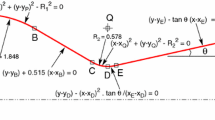Abstract
We present experimental results on separation of supersonic flow inside a convergent–divergent (CD) nozzle. The study is motivated by the occurrence of mixing enhancement outside CD nozzles operated at low pressure ratio. A novel apparatus allows investigation of many nozzle geometries with large optical access and measurement of wall and centerline pressures. The nozzle area ratio ranged from 1.0 to 1.6 and the pressure ratio ranged from 1.2 to 1.8. At the low end of these ranges, the shock is nearly straight. As the area ratio and pressure ratio increase, the shock acquires two lambda feet. Towards the high end of the ranges, one lambda foot is consistently larger than the other and flow separation occurs asymmetrically. Downstream of the shock, flow accelerates to supersonic speed and then recompresses. The shock is unsteady, however, there is no evidence of resonant tones. The separation shear layer on the side of the large lambda foot exhibits intense instability that grows into large eddies near the nozzle exit. Time-resolved wall pressure measurements indicate that the shock oscillates in a piston-like manner and most of the energy of the oscillations is at low frequency.
Similar content being viewed by others
References
Papamoschou, D.: Mixing enhancement using axial flow. AIAA Paper 2000-0093 (2000)
Murakami, E., Papamoschou, D.: Experiments on mixing enhancement in dual-stream jets. AIAA Paper 2001-0668 (2001)
Papamoschou, D., Dixon, T.D., Nishi, K.: Mean flow of multi-stream rectangular jets under normal and mixing-enhancement conditions, AIAA Paper 2004-0919 (2004)
Morrisette, E.L., Goldberg, T.J.: Turbulent flow separation criteria for overexpanded supersonic nozzle. NASA TP 1207 (1978)
Reshotko, E., Tucker, M.: Effect of a discontinuity on turbulent boundary layer thickness parameters with application to shock-induced separation. NACA TN-3454 (1955)
Wilmoth R.G., Leavitt L.D.: Navier Stokes predictions of multifunction nozzle flows. SAE Trans. 96(6), 6.865–6.879 (1987)
Hamed A., Vogiatzis C.: Overexpanded two-dimensional convergent-divergent nozzle flow simulations, Assessment of Turbulence Models. J. Propulsion Power 13(3), 444–445 (1997)
Hamed A., Vogiatzis C.: Overexpanded two-dimensional convergent-divergent nozzle flow performance, effects of three-dimensional flow interactions. J. Propulsion Power 14(2), 234–440 (1998)
Hunter, C.A.: Experimental, theoretical and computational investigation of separated nozzle flows. AIAA Paper 98-3107 (1998)
Romine G.L.: Nozzle flow separation. AIAA J. 36(9), 1618–1625 (1998)
Zaman K.B.M.Q., Dahl M.D., Bencic T.J., Loh C.Y.: Investigation of a transonic resonance with convergent-divergent nozzles. J. Fluid Mech. 263, 313–343 (2002)
Zaman, K.B.M.Q, Papamoschou, D.: Study of mixing enhancement observed with a co-annular nozzle configuration. AIAA Paper 2000-0094 (2000)
Papamoschou, D., Zill, A.: Fundamental investigation of supersonic nozzle flow separation. AIAA Paper 2004-1111 (2004)
Papamoschou, D., Johnson, A.: Unsteady phenomena in supersonic nozzle flow separation. AIAA Paper 2006-3360 (2006)
Anderson J.D.: Modern Compresible Flow. McGraw Hill, New York (1990)
Bourgoing A., Reijasse Ph.: Experimental analysis of unsteady separated flows in a supersonic planar nozzle. Shock Waves 14(4), 251–258 (2005)
Liepmann H.W.: The interaction between boundary layer and shock waves in transonic flow. J. Aero. Sci. 13(12), 623–637 (1946)
Sajben M., Bogar T.J., Kroutil J.C.: Characteristic frequencies of transonic diffuser flow oscillations. AIAA J. 21(9), 1232–1240 (1983)
Xiao Q., Tsai H.M., Liu F.: Computation of transonic diffuser flows by a legged k − ω turbulence model. AIAA J. 19(3), 473–483 (2003)
Plotkin K.J.: Shock wave oscillation driven by turbulent boundary-layer fluctuations. AIAA J. 13(8), 1036–1040 (1975)
Author information
Authors and Affiliations
Corresponding author
Additional information
Communicated by H. Olivier and A. Hadjadj.
Rights and permissions
About this article
Cite this article
Papamoschou, D., Zill, A. & Johnson, A. Supersonic flow separation in planar nozzles. Shock Waves 19, 171–183 (2009). https://doi.org/10.1007/s00193-008-0160-z
Received:
Accepted:
Published:
Issue Date:
DOI: https://doi.org/10.1007/s00193-008-0160-z




